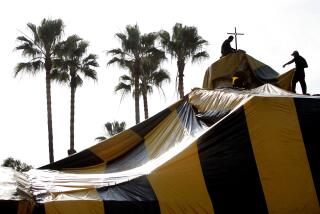Termites in the mulch? It’s time to squash that rumor
- Share via
The termites are coming! The termites are coming! But they aren’t coming in mulch harvested from trees downed by Katrina in the Gulf Coast region. They come every spring.
In what may be the greatest e-mail hoax since one involving the supposed sale of a Mrs. Fields cookie recipe, e-rumors have been flying about termite-infested mulch being shipped to big-box stores nationwide.
The e-mail -- origins unknown -- warns: “Be very careful about buying mulch this year. After the hurricane in New Orleans, many trees were blown over. These trees were then turned into mulch and the state is trying to get rid of tons and tons of this mulch to any state or company that will come and haul it away. So it will be showing up in Home Depot and Lowe’s at dirt-cheap prices with one huge problem: Formosan termites have gotten a strong hold, and most of the trees blown down were already badly infested with those termites.... These termites can eat a house in no time at all....”
Lowe’s has taken the matter so seriously that it has issued a there-are-no-termites-in-our-mulch statement. The chain has posted notices in its stores saying that no wood, timber or debris from the hurricane-damaged areas of Louisiana are present in any mulch it sells.
Home Depot is also assuring customers that it does not sell mulch from termite-infested trees or use any mulch suppliers from the New Orleans area. Home Depot requires that all its mulch suppliers be certified by the Virginia-based Mulch and Soil Council, a trade association for processors that establishes standards and soil certification.
Still, e-rumors of the foraging menace persist.
The Formosan subterranean is considered one of the most destructive termite species in the world. It takes only one king and one queen to produce an enormous colony, according to the U.S. Department of Agriculture. A mature colony can include millions of termites and produce 3,000 new ones a day -- all voracious eaters. The USDA estimates that in New Orleans alone, 30% of the trees are infested with Formosans. With roots in Asia, the Formosan termite is munching its way through Alabama, Arizona, Arkansas, California, Florida, Georgia, Hawaii, Louisiana, Mississippi, New Mexico, North and South Carolina, Texas and Virginia.
What do the experts say about the masses of killer termites rumored to be headed our way in mulch?
“Just can’t be,” said John Chapman, Terminix’s manager of technical services and No. 1 termite-stomper.
“First, they’d have to survive the chipping process. Then they’d have to survive the heat of those big piles of mulch. Did you ever see a front-loader move a big pile of mulch and see the steam from the heat come off it? And then they’d have to survive being stuffed into a plastic bag,” Chapman said. “No way.”
Louisiana has taken the additional step of quarantining its downed trees for proper disposal, he added. Since October, hurricane-affected parishes in Louisiana have been forbidden to transport mulch, wood or any kind of wood waste outside their area. The material is being put into landfills.
Terminix’s Todd Veden, an expert in Southern California’s termites, said it’s possible that mulch bought at commercial chains might be infested, but it “isn’t probable.”
Veden added that Angelenos shouldn’t be surprised if they see termite swarms as early as this week. Such swarms typically occur a few sunny days after a rain, he said. “But they’ll be our own native Western subterraneans, not the Formosans.”
Since this is the start of termite season, Veden advises keeping an eye out for a swarm of “a few hundred to a few thousand” ant-like insects with black bodies and four clear wings of equal length. If you see them, he says, call a termite inspector. Also call if you see mud structures around base moldings or under piles of books and magazines in the garage or basement, an indication that termites are building a safe passage from soil to wood.
Discarded wings on windowsills often are a sign of an infestation. After their short flight, swarmers break off their wings because they will never fly again.
Southern California is also home to four species of termites besides the Western subterranean -- the desert subterranean, the arid-land subterranean, the Western drywood and the Pacific dampwood, which prefers either high elevations or the cool and humid coast.
But none puts fear in the hearts of termite-chasers as much as the Formosan, which may explain why, expert assurances and denials aside, the e-rumors continue. Given that this is an Internet rumor, maybe it will take an Internet source to dispense with the matter.
From truthorfiction.com, a website that tracks down Internet rumors, comes this: “There is widespread and legitimate concern in Louisiana and other parts of the South about the destructive Formosan subterranean termite, but not because of mulch made from downed trees from New Orleans.”
According to the website, Afhok Raina, supervisory research entomologist for the Formosan subterranean termite research unit at the USDA, dismissed the rumor. But he still does not recommend putting mulch -- any mulch -- near a house. Pest-control professionals often establish a chemical barrier around a home to keep termites out and mulch can compromise that barrier. Experts also advise keeping wood piles and wooden fences away from your house.
Now, if we could just put that Mrs. Fields cookie recipe rumor to rest as well.
More to Read
Sign up for Essential California
The most important California stories and recommendations in your inbox every morning.
You may occasionally receive promotional content from the Los Angeles Times.










